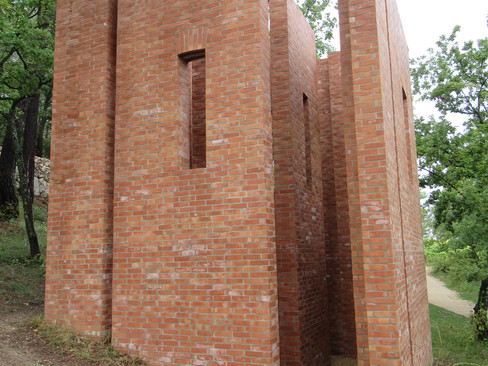Chateau La Coste
- Nigel Wakeham
- May 9, 2022
- 4 min read
Updated: Sep 18, 2023

Chateau La Coste
Following our visit to Arles (see the previous blog), we moved on to Marseille stopping off on the way at Chateau La Coste which is located in the Provencal countryside about 16 kilometres north of Aix-en-Provence.
Chateau La Coste is a 600-acre estate with, at its heart, a biodynamic vineyard and winery. The estate, which is owned and has been developed by an Irish businessman, Paddy McKillen, also contains a sculpture park and a small, luxury hotel. The sculpture park contains works of art and architecture by Tadao Ando, Louise Bourgeois, Hiroshi Sugimoto, Alexander Calder, Sean Scully, Larry Neufeld, Tunga, Jenny Holzer, Andy Goldsworthy, Per Kirkeby, Conrad Shawcross, Kengo Kuma, Lee Ufan, Sophie Calle, Ai Weiwei, Franz West, Ti-A, Jean-Michel Othoniel, Michael Stipe, Tracey Emin, Liam Gillick, Frank Gehry and Tony Berlant, Richard Serra, Paul Matisse, Tatsuo Miyajima, Tom Shannon, Richard Long, Yoko Ono, Guggi, Renzo Piano, Jean Nouvel and Richard Rogers.
The estate has been open to the paying public since 2011. The entrance building (by Tadao Ando) leads to a route around the estate that at present has 37 works by some of the world’s greatest artists and architects with apparently, more still to come (Oscar Niemeyer’s final building, an exhibition space was not finished at the time of our visit).
On the morning that we arrived a violent storm struck this part of France (when we reached Marseille in the evening, we heard that there had been torrential floods there during the afternoon) but fortunately, the storm missed the park.
The tour follows paths that wind around the wooded hillsides above the entrance and the old estate buildings and past olive groves and vineyards. The highlights of the tour were, for me, ‘La Chappelle’ by Tadao Ando, the new cantilevered gallery by Richard Rogers (his last building) and, for their simplicity, ‘Aix’ by Richard Serra and the winery buildings by Jean Nouvel with their curved, stainless steel roofs. We avoided Tracey Emin’s installation, and I was distinctly unimpressed, as usual, by the works of Frank Gehry. I did not understand the point of ‘ The Marriage of New York and Athens’ and his ‘Pavillon de Musique’ is looking distinctly past its sell by date (and the roof leaks!).
The real highlight though is the entrance building by Tadao Ando. This has two wings set at an angle to each other surrounded by a lake with an entrance space, exhibition spaces and internal and external dining areas (there is also a parking space below). In the lake are works by Louise Bourgeois (Crouching Spider), Hiroshi Sugimoto (Mathematical Model 012) and Alexander Calder (Small Crinkly). The construction is simple with a flat concrete roof, a floor of pre-cast concrete slabs, floor to ceiling glazing and full-height in-situ concrete walls.
The quality of the concrete (both here and in ‘La Chappelle’) is superb. I have never seen concrete like it anywhere else; it is faultless and must have cost a fortune! Ando is apparently a great admirer of Le Corbusier and his work but Corb’s concrete is rough and ready (beton-brut) ‘as-found’ from the formwork while Ando’s concrete is the exact opposite; great care has been to make the formwork perfect in layout and jointing and in the concrete mix and the release from the formwork giving the perfection seen here.
Both buildings are simple and very beautiful but the question raised of course by the use of such quantities of concrete for walls, floors and roofs, in these times of climate change and global warming, is whether we as architects should be using concrete at all given the amount of CO2 that the use of it produces let alone the insistence seen here of perfection in its use.
We had lunch, with wine from the estate, in the Tadao Ando restaurant which was very good and I would encourage anyone with an interest in art and architecture who find themselves in the area to visit the estate for both the natural beauty of the setting and for the inspiration to be found in at least some of the art and architecture on display.
The gallery below shows some of the artworks to be seen on the estate.
Architecture in Developing Countries: A Resource
The design and construction of appropriate, low-cost buildings for education and health in rural areas of the developing world.
Nigel Wakeham is an architect who lived for 23 years in Southern and West Africa and the SW Pacific working on education, health and other projects. He has since worked for over 20 years as a consultant for national governments and agencies such as the World Bank, DFID, ADB and AfDB on the implementation of the construction components of education and health projects in many countries in the developing world.
The objective of this website will be to provide the benefit of more than 45 years of experience of working in developing countries to architects and other construction professionals involved in the design and construction of appropriate, low-cost buildings for education and health. It will provide reference material from the projects that Nigel has worked on and technical information on the design, construction and maintenance of educational and health facilities and other relevant topics and these will be added to from time to time.
I am happy to be contacted by anyone requiring further information on any of the projects or resources referred to in this website or by anyone wishing to discuss work possibilities.














































































Comments